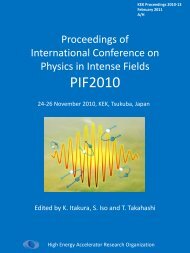TRIAC Progress Report - KEK
TRIAC Progress Report - KEK
TRIAC Progress Report - KEK
You also want an ePaper? Increase the reach of your titles
YUMPU automatically turns print PDFs into web optimized ePapers that Google loves.
The process of nuclear polarization by the TF technique is schematically shown in<br />
Fig. 3-13: The tilted-foil method uses the anisotropic atomic collision of incident ions<br />
with the conduction (constituent) electrons at the exit surface of the foil. When the ion<br />
beams passing through a thin foil, tilted against the incident beam direction at an<br />
oblique angle (θ in Fig. 3-13), the electronic states of the outgoing ions are polarized.<br />
Polarization is initially introduced in the orbital motion of the electrons by the surface<br />
interaction at the instant of exit of ions from the foil. During flight in free space, some<br />
of this electron spin (J) polarization is transferred to the nuclear spin (I) through<br />
hyperfine interaction. The direction of the polarization is well defined; n x v where n is<br />
the unit vector normal to the surface of the foil at the exit and v is the ion’s velocity. By<br />
a successive passage of several such foils, interspersed with regions of free flight to<br />
allow a significant nuclear precession around the total angular momentum F=I+J in<br />
flight, the polarization effect is enhanced. In this way, rather sizable nuclear polarization,<br />
~10 %, for a wide variety of elements can be achieved [3-18].<br />
The features of this method can be summarized as follows: The method is<br />
applicable to any elements and the RIBs of a few hundred keV/nucleon are considered<br />
to be most suitable for the effective capture of electrons, which is essential for the<br />
primary atomic polarization. The degree of polarization increases with the number of<br />
foils [3-19] and the tilted angle between the beam axis and the axis normal to the foil<br />
surface [3-20]. The direction of polarization is easily reversed by reversing the normal<br />
axis of the foil surface. The degree of nuclear polarization PI induced by the multi-foil<br />
can be approximated as follows [3-21],<br />
N { Q } PJ<br />
I + 1<br />
PI ( N)<br />
~ 1−<br />
.<br />
J + 1<br />
Here, N is the number of foils, I and J are respectively nuclear and atomic spin, PJ is the<br />
degree of atomic polarization and Q is expressed approximately for small PJ by:<br />
2 2<br />
1− 2/<br />
3⋅<br />
J / I if I / J > 1 , 1 / 2 if I / J = 1 , 1 / 3 if I / J < 1 . From the nuclear<br />
polarization measured as a function of the number of foils, dominant atomic state for the<br />
atomic and nuclear polarization could be estimated by using the equation for PI.<br />
Experimental setup: Figure 3-14 shows a schematic side view of the experimental<br />
setup for the production and measurement of nuclear polarization. Reaccelerated RIBs<br />
pass through a stack of tilted-foils in vacuum chamber. After being spin-polarized by the<br />
TF method, they are implanted into a catcher (often called as catcher or stopper foil),<br />
where a magnetic field B0 is applied to preserve the nuclear polarization. The catcher<br />
can be cooled by a refrigerator (down to about 10 K, if necessary) in order to achieve<br />
66













